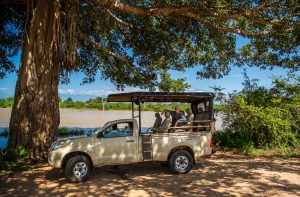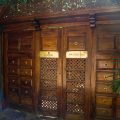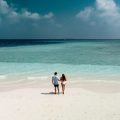Udawalawe National Park is a haven for a huge variety of wild animals, not only the magnificent Sri Lankan Elephants you will see. It is the third most visited National Park in Sri Lanka. This was actually a male elephant that greeted us into Udawalawe on the outskirts of the National Park. It seems the locals plow him with food and that’s why he is almost a hotel guest in his own right!

When to visit?
We visited in December 2021 and it was a perfect day with a slight breeze from the back of the jeep. It is said to be best to visit the National Park from November – May with those particular months being the end and beginning of the rainy season.
How to visit?
We recommend staying in Udawalawe like us. Throughout our travels we have found that tours from other places in the country take up so much time just getting there and travelling back that it isn’t really worth the money. If you are tight on time, there are tours available from anywhere within 100 miles of the National Park.
Prices
Full day tour: 22,500LKR for two people (in 2021)
Half day tour: 9,000 LKR for two people (in 2021)
Entrance to the National Park: 8,700LKR (This price was for 2 x foreigners, 1 x driver and 1 x jeep.) This is not included in the tour price and must be paid in addition in LKR. Check with your tour provider what is included in the price. It is also worth mentioning that this price is for a private jeep tour due to no other tourists being on board. So if price is something that matters to you, the more in the jeep the merrier!

We chose to do a full day tour of the National Park with lunch included which was maybe a little much for us. A half day tour would take around 3 hours and by that time we had already seen loads of elephants, birdlife and other wildlife. A full day tour meant that we had a packed lunch provided which we ate at what seemed to be an abandoned campsite (again seeing the effects of the lack of tourists due to Coronavirus.) After which we drove around again for a few hours seeing many more animals (most of which we had already seen). We were driven to some amazing view points, from which you could see for miles the landscape of the area which we very much enjoyed. It sounds pathetic but we were exhausted after starting at 08:30 and ending at 16:00.
What animals can you see?
Elephants – There is believed to be approximately 500 elephants living in the National park. During our time adventuring around the park we saw around an abundance of elephants, some males travelling solo, a mother and her calf and some that seemed to be families. You WILL see elephants!

Birdlife – Udawalawe National Park is an amazing place to witness birds of prey. We were fortunate to see a Peregrine falcon pretty close!

From the back of the jeep we also saw Ospreys, Peacocks, Painted storks, Green bea-eaters, Herons and many other beautiful birds. There is a huge variety of birdlife to see here. If birdlife is the main attraction to your visit then maybe a bird watching tour is more for you.

Reptiles – During our visit we saw Monitor Lizards, Water Lizards, Snakes and a Turtle (sunbathing to warm the blood). Our driver was also on the lookout for crocodiles for the whole day to no avail.
Other Wildlife – Alongside the main attraction of the national park, the elephants, you can see many other wildlife. We saw Water Buffalo, Spotted Deer, Gray Langurs, Toque Macaques and Jackals. Catching sight of a leopard would be a bonus.

By the way, ever seen a bird ride a rabbit? It could be said that this was the highlight of our day. (Quality is awful due to zooming in in post.)

Was it worth it?
YES! Our visit to Udawalawe National Park is probably a blip in the system due to it being so quiet when we visited. This made the experience so dreamy for us and therefore we can only comment on our experience. If it was rammed with jeeps and tourists we may not be so cheery about our time spent here.
We were told by our driver that at certain places throughout the park, prior to the Coronavirus, there could be 50 jeeps all queued up at certain viewpoints. We only saw 5 other jeeps on our 7 hour visit. It leaves a bittersweet feeling. On the one hand, there is less interruption to the wildlife, but on the other the livelihoods of so many people is still impacted nearly 2 years since the beginning of the pandemic.

Where to stay?
Just outside the National Park there are reams of hotels, homestays and other accommodation. We stayed at Elephant Trail Hotel and were very much looked after, you can check the hotel out here! Due to the Coronavirus it was clear to see that these accommodations were struggling and in fact we were the only ones staying in our hotel. Although this was the case we were cooked a very personal meal every night at a time we so desired.

Why Udawalawe over other National Parks?
Only through research prior to our trip to Sri Lanka did we work out a route which seemed to include Udawalawe very well as opposed to others. With tourism ever increasing across the world especially in post covid times (hopefully in the near future), it is important to think about sustainability. Udawalawe National Park have a Nature Based Tourism Plan which was a very interesting read and one that made the decision for us. You can read the Tourism Plan for the National Park here.

Hints and Tips
1) If you dislike mosquitoes and various other insects we suggest avoiding eating at dusk or night, you will be covered in insects. Same with your room, turn off all lights otherwise you’ll be sharing your room with many others.
2) Request a mosquito net for your room if you have not got one already in place. This is a must!
3) Don’t wear a light coloured shirt like Tom, it got absolutely caked in dirt, which we only noticed the day after alongside the curry stain…

4) If you’re a lover of photography and are travelling purely to see wildlife then this may seem basic coming from us – bring a long lens. We were unfortunately at our tightest at 105mm which was not long enough to photograph the magnificent birds and wildlife living here.
Now, if you go North and follow us on our adventure trek you can read about Adam’s Peak by clicking here!
Alternatively, if you are heading South then read about Hiriketiya/Dikwella here! For now here’s another photo of the National Park, so beautiful.

Travelling Translated
This blog might contain affiliate links. This means if you click on it and buy something, we’ll possibly make a small commission from it, at no additional cost to you. This enables us to keep sharing our travel tips and stories for you to enjoy.



